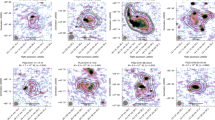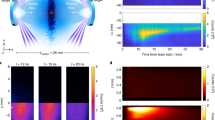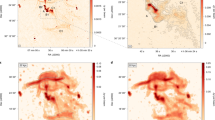Abstract
The standard model for the origin of galactic magnetic fields is through the amplification of seed fields via dynamo or turbulent processes to the level consistent with present observations1,2,3. Although other mechanisms may also operate4,5, currents from misaligned pressure and temperature gradients (the Biermann battery process) inevitably accompany the formation of galaxies in the absence of a primordial field. Driven by geometrical asymmetries in shocks6 associated with the collapse of protogalactic structures, the Biermann battery is believed to generate tiny seed fields to a level of about 10−21 gauss (refs 7, 8). With the advent of high-power laser systems in the past two decades, a new area of research has opened in which, using simple scaling relations9,10, astrophysical environments can effectively be reproduced in the laboratory11,12. Here we report the results of an experiment that produced seed magnetic fields by the Biermann battery effect. We show that these results can be scaled to the intergalactic medium, where turbulence, acting on timescales of around 700 million years, can amplify the seed fields13,14 sufficiently to affect galaxy evolution.
This is a preview of subscription content, access via your institution
Access options
Subscribe to this journal
Receive 51 print issues and online access
$199.00 per year
only $3.90 per issue
Buy this article
- Purchase on Springer Link
- Instant access to full article PDF
Prices may be subject to local taxes which are calculated during checkout




Similar content being viewed by others
References
Parker, E. N. Hydromagnetic dynamo models. Astrophys. J. 122, 293–314 (1955)
Zweibel, E. G. & Heiles, C. Magnetic fields in galaxies and beyond. Nature 385, 131–136 (1997)
Ryu, D., Kang, H., Cho, J. & Das, S. Turbulence and magnetic fields in the large-scale structure of the universe. Science 320, 909–912 (2008)
Schlickeiser, R. & Shukla, P. K. Cosmological magnetic field generation by the Weibel instability. Astrophys. J. 599, L57–L60 (2003)
Miniati, F. & Bell, A. R. Resistive magnetic field generation at cosmic dawn. Astrophys. J. 729, 73, 10.1088/0004-637X/729/1/73 (2011)
Miniati, F. et al. Properties of cosmic shock waves in large-scale structure formation. Astrophys. J. 542, 608–621 (2000)
Kulsrud, R. M., Cen, R., Ostriker, J. P. & Ryu, D. The protogalactic origin for cosmic magnetic fields. Astrophys. J. 480, 481–491 (1997)
Xu, H. et al. The Biermann battery in cosmological MHD simulations of population III star formation. Astrophys. J. 688, L57–L60 (2008)
Ryutov, D. D. et al. Similarity criteria for the laboratory simulation of supernova hydrodynamics. Astrophys. J. 518, 821–832 (1999)
Ryutov, D. D., Drake, R. P. & Remington, B. A. Criteria for scaled laboratory simulations of astrophysical MHD phenomena. Astrophys. J. Suppl. Ser. 127, 465–468 (2000)
Remington, B. A., Arnett, D., Drake, R. P. & Takabe, H. Modeling astrophysical phenomena in the laboratory with intense lasers. Science 284, 1488–1493 (1999)
Remington, B. A., Drake, R. P. & Ryutov, D. D. Experimental astrophysics with high power lasers and Z pinches. Rev. Mod. Phys. 78, 755–807 (2006)
Cho, J. & Vishniac, E. T. The generation of magnetic fields through driven turbulence. Astrophys. J. 538, 217, 10.1086/309127 (2000)
Sur, S., Schleicher, D. R. G., Banerjee, R., Federrath, C. & Klessen, R. S. The generation of strong magnetic fields during the formation of the first stars. Astrophys. J. 721, L134–L138 (2010)
Hansen, J. F. et al. Laboratory simulations of supernova shockwave propagation. Astrophys. Space Sci. 298, 61–67 (2005)
Hansen, J. F. et al. Laboratory observation of secondary shock formation ahead of a strongly radiative blast wave. Phys. Plasmas 13, 022105 (2006)
MacFarlane, J. J., Golovkin, I. E. & Woodruff, P. R. HELIOS-CR—a 1-D radiation-magnetohydrodynamics code with inline atomic kinetics modeling. J. Quant. Spectrosc. Radiat. Transf. 99, 381–397 (2006)
Everson, E. T. et al. Design, construction, and calibration of a three-axis, high-frequency magnetic probe (B-dot probe) as a diagnostic for exploding plasmas. Rev. Sci. Instrum. 80, 113505 (2009)
Bell, A. R. & Kingham, R. J. Resistive collimation of electron beams in laser-produced plasmas. Phys. Rev. Lett. 91, 035003 (2003)
Reich, Gibbon, P., Uschmann, I. & Föster, E. Yield optimization and time structure of femtosecond laser plasma Kα sources. Phys. Rev. Lett. 84, 4846–4849 (2000)
Hayes, W. D. The vorticity jump across a gasdynamic discontinuity. J. Fluid Mech. 2, 595–600 (1957)
Medvedev, M. V. Weibel turbulence in laboratory experiments and GRB/SN shocks. Astrophys. Space Sci. 307, 245–250 (2007)
Bernet, M. L., Miniati, F., Lilly, S. J., Kronberg, P. P. & Dessauges-Zavadsky, M. Strong magnetic fields in normal galaxies at high redshift. Nature 454, 302–304 (2008)
Murphy, E. J. The far-infrared-radio correlation at high redshifts: physical considerations and prospects for the square kilometer array. Astrophys. J. 706, 482–496 (2009)
Ziegler, U. A central-constrained transport scheme for ideal magnetohydrodynamics. J. Comput. Phys. 196, 393–416 (2004)
Zel’dovich, Ya. B. & Raizer, Yu. P. Physics of Shock Waves and High-Temperature Hydrodynamic Phenomena (Academic, 1966)
Acknowledgements
We thank the LULI technical team for their support during the experiments. The research leading to these results has received funding from the European Research Council under the European Community’s Seventh Framework Programme. This work was also supported by the EU programme Laserlab-Europe. Partial support from the Science and Technology Facilities Council (the Central Laser Facility and the Centre for Fundamental Physics) and the Engineering and Physical Sciences Research Council of the United Kingdom is also acknowledged.
Author information
Authors and Affiliations
Contributions
G.G. and F.M. conceived the project. G.G., A.R., C.D.M., A.B.-M., M.E., C.D.G., Y.K., J.M., H.-S.P., N.C.W. and M.K. carried out the LULI experiment. The paper was written by G.G., A.R., A.R.B., R.P.D., B.R. and F.M. The data was analysed by G.G., A.R., C.D.M., K.S. and C.D.G. Preparatory diagnostics work was conducted by A.B., C.C., E.T.E., C.N., W.L. and S.Y. Numerical simulations were performed by G.G. and A.P.L.R. Additional experimental and theoretical support was provided by A.R.B., R.B., R.P.D., B.A.R., B.R., D.D.R., Y.S. and F.M.
Corresponding authors
Ethics declarations
Competing interests
The authors declare no competing financial interests.
Supplementary information
Supplementary Information
This file contains Supplementary Text and Data, Supplementary Figures 1-2 with legends and additional references. (PDF 1149 kb)
Rights and permissions
About this article
Cite this article
Gregori, G., Ravasio, A., Murphy, C. et al. Generation of scaled protogalactic seed magnetic fields in laser-produced shock waves. Nature 481, 480–483 (2012). https://doi.org/10.1038/nature10747
Received:
Accepted:
Published:
Issue Date:
DOI: https://doi.org/10.1038/nature10747
This article is cited by
-
Self-organization of photoionized plasmas via kinetic instabilities
Reviews of Modern Plasma Physics (2023)
-
Direct observations of pure electron outflow in magnetic reconnection
Scientific Reports (2022)
-
Plasma physics and astrophysics: retrospects, state-of-the art, and prospects
Rendiconti Lincei. Scienze Fisiche e Naturali (2021)
-
Laboratory evidence of dynamo amplification of magnetic fields in a turbulent plasma
Nature Communications (2018)
-
Magnetic turbulence in a table-top laser-plasma relevant to astrophysical scenarios
Nature Communications (2017)
Comments
By submitting a comment you agree to abide by our Terms and Community Guidelines. If you find something abusive or that does not comply with our terms or guidelines please flag it as inappropriate.



